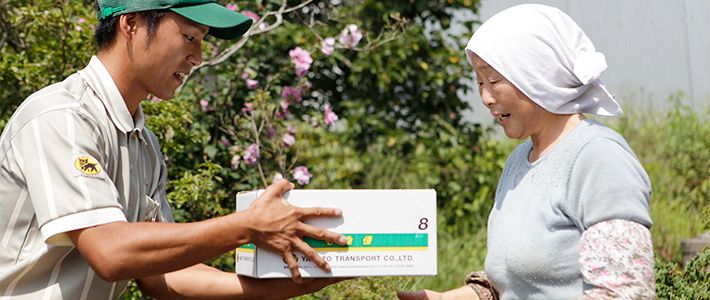
“Takuhai” Delivery Service
Society- English
- 日本語
- 简体字
- 繁體字
- Français
- Español
- العربية
- Русский
Convenience and Reliability
Japan’s takuhai delivery services deliver a wide variety of packages including perishables, fragile and large-sized items, electronics, and luggage safely, quickly, and at a reasonable price. With a single phone call or trip to a neighborhood convenience store, customers can arrange for items to be delivered reliably anywhere in Japan and as many as 200 locations overseas.
Travelers frequently turn to takuhai to simplify their trips, sending cumbersome baggage ahead to hotels or back home after their journey. For example, skiers and snowboarders heading to the slopes by train face the burden of lugging heavy and unwieldly equipment through stations and crowded carriages. But by simply calling a delivery service they can travel to the powder unencumbered. In this and other ways, takuhai have transformed how many in Japan travel.
 Takuhai services will deliver packages anywhere in Japan, as well as select areas overseas. (© Yamato Transport Co., Ltd.)
Takuhai services will deliver packages anywhere in Japan, as well as select areas overseas. (© Yamato Transport Co., Ltd.)
As demand for Japanese products grows overseas, facilities like Yamato Transport’s Haneda Chronogate are helping ensure that items reach their global destinations quickly. The 24-hour super-hub utilizes the latest logistics technology, such as complex systems of cross-belt sorters. For people interested in the facility, Yamato Transport provides free 90-minute tours in English and Chinese, allowing visitors to view the inner workings of the vast terminal.
Using a Delivery Service
Sending a package is as simple as filling out a shipping label and paying a fee. Most delivery services use a similar format, making the process easy for customers.
Customers can specify the day and time they would like their package to arrive, removing the need to wait around. Even if they miss the delivery driver, they can use the fuzai denpyō (failure of delivery notice) to call and easily arrange a new delivery time. (These notices often include the drivers’ mobile phone numbers, letting the recipient get in touch while they are still in the neighborhood to arrange redelivery.) It is even possible to have a parcel sent to a nearby convenience store, a popular option as it allows customers to pick up packages while running errands or on the way home from work.
Delivery charges for takuhai are determined by package size, making it easy to quickly ascertain shipping costs. Fees may be required upfront, but cash-on-delivery options are also available. The growth of online shopping has been accompanied by an increase in purchases being sent by takuhai. Recently, the payment system at many sites, which previously required payment verification prior to shipping, has been simplified to allow customers to order something on the Internet and pay for it COD.
Cold Storage
A distinct takuhai characteristic is the ability to ship items needing to be kept refrigerated or frozen. Delivery service companies maintain the cold chain using a fleet of special trucks, so travelers to a seaside town on one end of Japan can send fresh seafood to friends or family members on the other, certain that their gift will arrive tasting as delicious as when purchased. These cool takuhai services can be used for a wide variety of items, including homemade goods as well as store-bought delicacies.
 A delivery person walks through the snow with a cooler box. (© Yamato Transport)
A delivery person walks through the snow with a cooler box. (© Yamato Transport)
 Crab from Hokkaidō can be delivered anywhere in the country using the chilled takuhai service.
Crab from Hokkaidō can be delivered anywhere in the country using the chilled takuhai service.
The Beginnings of Takuhai
The forerunner of takuhai appeared in 1976 when existing office delivery services were extended to include nonbusiness customers. Service was initially restricted to the Kantō area, which includes Tokyo. Initial reaction was muted—one company received only 11 delivery requests on its first day of business—but demand rapidly grew, with numerous firms quickly moving to join the market.
Since its inception, takuhai has continued to evolve. In the 1980s, the expansion of the national highway system allowed companies to shorten delivery times and broaden the scope of the now commonplace “next day delivery” service. In 2007, the newly privatized Japan Post joined the market, backed by its extensive domestic and overseas network. Convenience stores have also moved in, serving as 24-hour pick-up and drop-off points, which, along with the availability of post offices, have made takuhai an aspect of daily life.
Delivery service companies are constantly providing new offerings to keep in line with changing demands. In response to the graying of Japan’s population, certain companies offer senior services, such as delivering broken household items to a shop for repairs or picking up groceries from the supermarket. As the convenience of takuhai grows, it’s becoming increasingly difficult for many people to imagine life without it.
(Banner photo: A delivery person bringing a package to a customer. © Yamato Transport.)
Links of interest:
Yamato Transport Sagawa Express Japan Post
Photo credits:
Chilled takuhai crab: mount
convenience store Japan Post Yamato Transport Sagawa Express delivery
